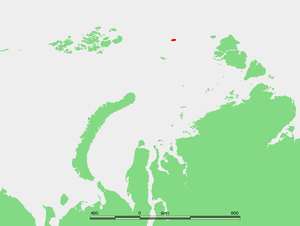Ushakov Island
| Ushakov Island | |
|---|---|
| Outlines of Ushakov Island | |
| Waters | Kara Sea |
| Geographical location | 80 ° 48 ′ N , 79 ° 29 ′ E |
| length | 25.5 km |
| width | 17.5 km |
| surface | 324 km² |
| Highest elevation | 294 m |
| Residents | uninhabited |
The Ushakov Island ( Russian Остров Ушакова / Ostrow Uschakowa ) is a 324 km² large isolated island in the Arctic Ocean belonging to Russia . It is located in the northern Kara Sea , halfway between Franz Josef Land in the west and Severnaya Zemlya in the east. As to the administrative division, it belongs to Taimyrsky Raion (Dolgano-Nenezki) of Krasnoyarsk Territory . The closest landmass is the lonely meadow island , 140 km further south.
The surface of Ushakov Island is completely covered by an ice cap , the greatest height of which is 294 m. The rock below is flat and partially below sea level. The edge of the ice is formed by a 20 to 30 meter high cliff that slopes steeply into the sea . Between 1950 and 2000, the area of the ice cap - and thus the island - decreased by two square kilometers, but the volume of the ice increased from 35 to 38 cubic kilometers. The average ice thickness increased from 107 to 118 meters during this time.
Due to its extreme northern location, the sea surrounding Ushakov Island is covered with pack ice in winter and with ice floes during the short summer . The annual number of days with a positive air temperature is not higher than 30. The mean annual rainfall is 200 mm at 50 m height and 350 to 400 mm at the highest point of the ice cap.
history
The island was only discovered in 1935, when the few remaining unknown areas of the northern Kara Sea were explored by an expedition led by the Soviet polar explorer, cartographer and oceanologist Georgi Ushakov with the icebreaker Sadko . It was named after Ushakov. From 1954 to the end of the 1980s there was a polar station on Ushakov Island. The first wintering on the island was carried out from 1954 to 1955. In 2001 only two houses could be seen from the station, some of which had sunk into the ice, one of them up to the roof.
Web links
Individual evidence
- ↑ a b Aleksey I. Sharov, Roland Pail , Roland Perko, Daniel Rieser, Florian Heuberger, Christoph Gisinger: Variations of the Arctic Ice-Snow Cover in Nonhomogeneous Geopotential (PDF; 660 kB). In: Proc. ESA Living Planet Symposium , Bergen, Norway June 28 - July 2, 2010 (ESA SP-686, December 2010)
- ↑ VV Bogorodsky, CR Bentley, PE Gudmandsen: Radioglaciology , D. Reidel, Dordrecht 1985, ISBN 978-94-010-8830-5 , doi : 10.1007 / 978-94-009-5275-1 , p. 5 (English)
- ↑ a b Andrey F. Glazovskiy: Russian Arctic , chap. 2.7 in: Jacek Jania, Jon Ove Hagen (eds.): Mass Balance of Arctic Glaciers (PDF; 132 kB), IASC Report No. 5, Sosnowiec-Oslo 1996.
- ↑ About the polar station on Ushakov Island (Russian) ( Memento from October 17, 2016 in the Internet Archive )

